Open source and free shadcn templates using Tailwind
188 templates • 159 contributors • Open source & free
188
Templates
159
Authors
Available Templates (188)

CSS Selector Tool
The CSS Selector Tool is a powerful low-code web scraping and data extraction utility designed for developers, QA engineers, and data analysts who need to test and debug CSS selectors efficiently. Built with Next.js 14, React, TypeScript, and shadcn/ui components, this developer tool provides an interactive interface for selecting elements on any webpage, generating precise CSS selectors, and extracting data with built-in proxy and parsing capabilities. The application features a visual element picker that highlights elements on hover, automatic selector generation with specificity optimization, XPath alternative generation, real-time selector testing and validation, and a built-in proxy system for accessing content behind authentication or geo-restrictions. Users can load any website URL, click to select elements visually, generate and copy optimized CSS selectors, test selectors in real-time with instant feedback, and export extracted data in various formats including JSON and CSV. The tool is invaluable for web scraping projects where precise element selection is critical, automated testing scenarios requiring reliable element locators, data extraction workflows from dynamic websites, and debugging complex CSS selector issues in production applications. Whether you're building a web scraper, writing automated tests, or troubleshooting element selection issues, this CSS Selector Tool streamlines the process of identifying and validating the right selectors for your needs.
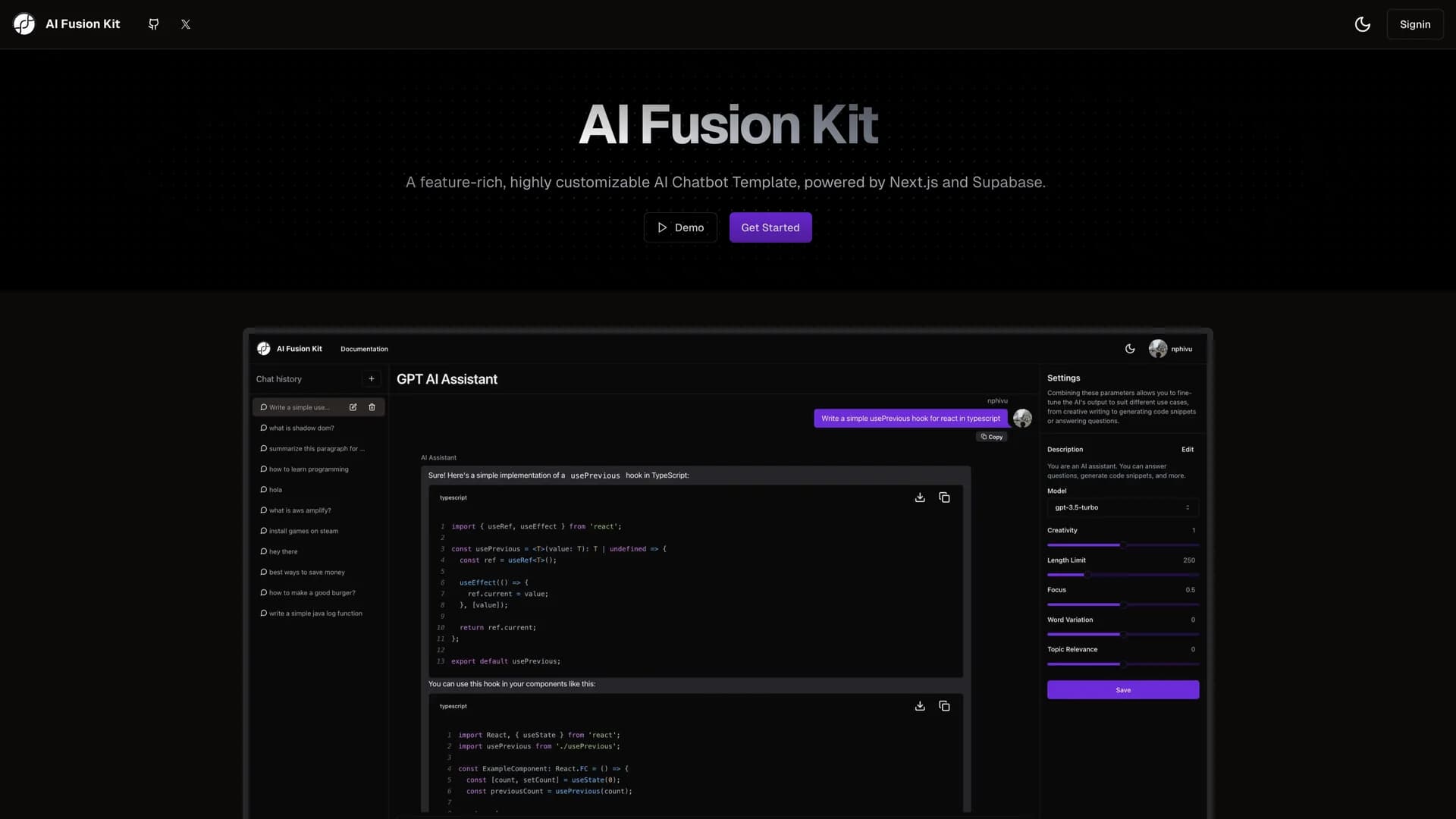
AI Fusion Kit
AI Fusion Kit is a comprehensive, production-ready AI web application template that accelerates the development of modern AI-powered applications with Next.js 14, React, TypeScript, and shadcn/ui. Built on the App Router architecture, this feature-rich template integrates Supabase for authentication and database management, OpenAI for AI capabilities, and Stripe for payment processing, providing a complete foundation for building SaaS products with AI features. The template includes pre-built AI chat interfaces with streaming responses, user authentication and profile management, subscription and billing integration, responsive UI components following shadcn/ui design patterns, database schema with Supabase migrations, middleware for protected routes, and webhook handlers for Stripe events. The modular architecture allows developers to customize AI models, swap authentication providers, adjust pricing tiers, and extend the component library while maintaining type safety throughout. Use cases include launching AI chatbot applications with subscription monetization, building AI writing assistants or content generation tools, creating customer support platforms with AI-powered responses, and developing AI research or experimentation interfaces. The template significantly reduces development time by providing battle-tested patterns for authentication, payments, AI integration, and database management, allowing teams to focus on unique product features rather than boilerplate setup.
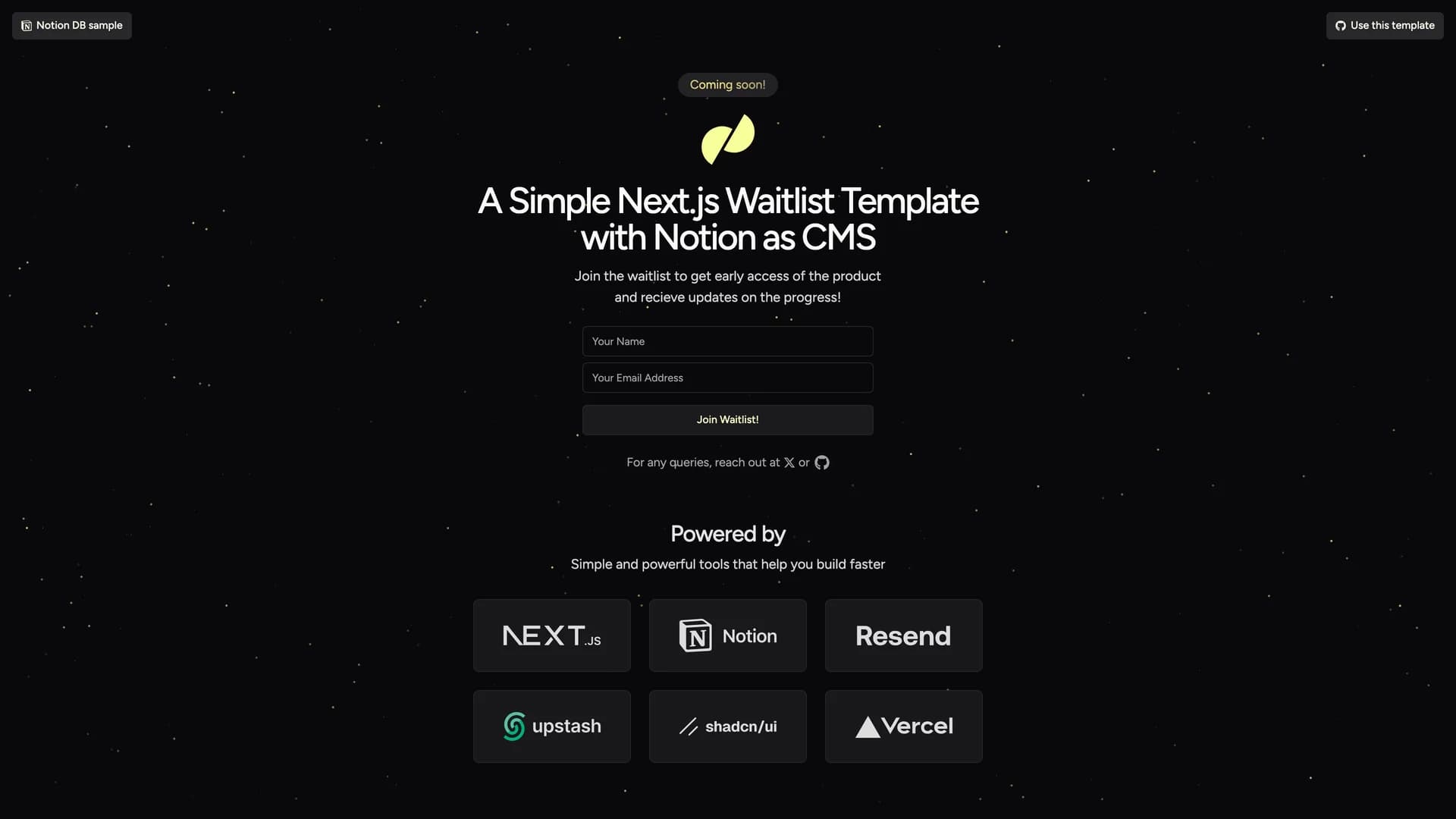
Next.js Notion Waitlist Template
The Next.js Notion Waitlist Template is an elegant, production-ready solution for building and managing product waitlists using Next.js 14, Notion as a headless CMS, and modern web technologies. Built with TypeScript, Tailwind CSS, and shadcn/ui components, this template enables founders and product teams to quickly launch beautiful waitlist pages that capture early user interest, manage signups, and send automated confirmation emails. The stack integrates Notion as a database for storing and organizing waitlist entries, Upstash Redis for rate limiting to prevent spam and abuse, Resend for transactional email delivery with custom domain support, and shadcn/ui for a polished, responsive user interface. Key features include a sleek waitlist signup form with email validation, automatic storage of submissions in a Notion database, rate limiting to protect against bot submissions, automated welcome emails sent via Resend, real-time form validation and error handling, responsive design that works on all devices, and easy customization of colors, copy, and branding. The template is perfect for launching product pre-launches and beta signups, building early user communities before a product launch, collecting interested leads for SaaS products, creating event registration and RSVP systems, and managing limited-access program applications. With minimal configuration required, teams can deploy a professional waitlist page in minutes while maintaining full control over the data in their Notion workspace.

Carhive
CarHive is a full-featured car rental marketplace application built with Next.js 14 App Router, TypeScript, and modern web technologies to demonstrate best practices for building e-commerce platforms. Powered by Clerk for authentication, Vercel Postgres for database management, Drizzle ORM for type-safe database queries, and shadcn/ui components for the interface, this project showcases how to build a production-ready rental platform with advanced features. The application includes comprehensive vehicle listings with detailed specifications and high-quality images managed through Cloudinary, advanced search and filtering by location, price, vehicle type, and availability, dynamic routing for individual car detail pages, user authentication with role-based access control via Clerk, Stripe integration for secure payment processing and booking transactions, an infinite logo slider showcasing partner brands, responsive design optimized for mobile and desktop experiences, and database schema with proper relationships between users, vehicles, and bookings. CarHive serves as an excellent reference for developers building marketplace applications where multiple vendors or inventory items need detailed presentation, e-commerce platforms requiring payment integration and booking systems, rental or reservation systems for equipment, properties, or services, and any project requiring image optimization and CDN integration with Cloudinary. The codebase demonstrates professional patterns for state management, form handling, database migrations, and API route organization in Next.js applications.

Shadcn UI FullCalendar Example
The shadcn/ui FullCalendar Example is a practical demonstration of integrating FullCalendar, one of the most popular JavaScript calendar libraries, with Next.js and shadcn/ui components to create modern scheduling and event management interfaces. Built with Next.js 14, React, TypeScript, Tailwind CSS, and React Aria for accessibility, this example project shows developers how to combine FullCalendar's powerful features with shadcn/ui's beautiful component design system. The implementation includes a fully interactive calendar with month, week, and day views, event creation and editing with modal dialogs using shadcn/ui Dialog components, drag-and-drop event rescheduling directly on the calendar, event deletion and management capabilities, responsive design that adapts to mobile and desktop screens, accessible UI patterns through React Aria integration, and customizable styling that matches shadcn/ui's design language. The project demonstrates how to properly initialize FullCalendar in a Next.js environment, manage calendar state in React components, style FullCalendar to match shadcn/ui themes, and handle event CRUD operations with TypeScript type safety. This template is ideal for building appointment scheduling systems for healthcare or service businesses, team calendar applications for project management, event management platforms for conferences or meetups, booking systems for resources or meeting rooms, and any application requiring rich calendar functionality with a modern UI. The example serves as a solid foundation for developers who want to quickly add calendar features to their Next.js applications without starting from scratch.

Stack Auth Multi Tenant Starter Template
The Stack Auth Multi-Tenant Starter Template is a minimalistic yet powerful foundation for building B2B SaaS applications with multi-tenancy architecture using Next.js 14 and Stack Auth. Built with React, TypeScript, Tailwind CSS, and shadcn/ui components, this template demonstrates how to implement organization-based multi-tenancy where users can belong to multiple teams or workspaces, similar to platforms like Slack, Notion, or GitHub. Stack Auth provides the authentication infrastructure with built-in support for user management, team/organization creation and switching, role-based access control (RBAC) within organizations, invitation systems for adding team members, and OAuth providers for social login. The template includes pre-configured authentication flows with organization context, team switching functionality in the UI, protected routes with organization-level permissions, user profile and settings pages, team management dashboards for admins, and responsive layouts using shadcn/ui components. Developers can quickly build collaborative SaaS platforms where users work in teams, B2B applications requiring workspace isolation and permissions, project management tools with organization hierarchies, customer portal applications with multi-account access, and any application where users need to switch between different organizational contexts. The minimalistic design focuses on essential multi-tenancy patterns without overwhelming complexity, making it easy to understand the architecture and extend with custom features. Stack Auth handles the complex authentication and authorization logic, allowing developers to focus on building unique product features rather than reinventing authentication systems.
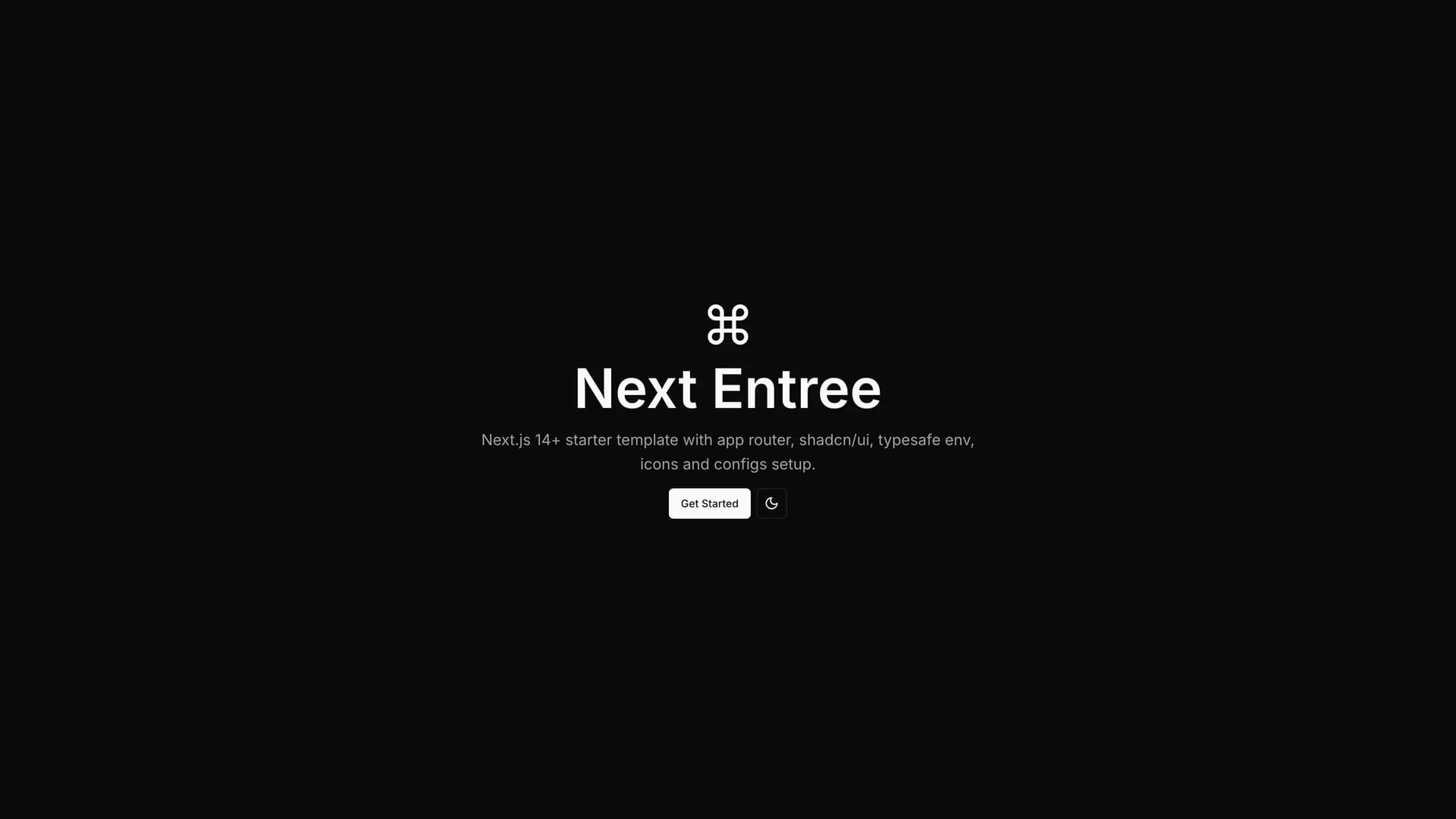
Next Entree
Next Entree is a thoughtfully configured Next.js 14+ starter template designed to help developers start new projects with best practices and essential tooling already in place. Built with the App Router architecture, TypeScript, Tailwind CSS, and shadcn/ui components, this template eliminates the repetitive setup process that developers face when starting fresh Next.js projects. The starter includes type-safe environment variable management with validation using @t3-oss/env-nextjs to catch configuration errors at build time, pre-configured icon libraries (Lucide, Radix Icons) ready to use, ESLint and Prettier configured for consistent code style, absolute imports with path aliases for cleaner import statements, recommended VS Code settings and extensions, optimized Tailwind CSS configuration, and basic shadcn/ui components already installed. The template emphasizes developer experience with sensible defaults that can be easily customized, reducing the time from 'create next app' to writing actual application code from hours to minutes. Next Entree is perfect for developers starting new side projects or MVPs who want to skip boilerplate setup, teams establishing consistent project structures across multiple applications, hackathon participants who need to move fast with reliable foundations, agencies building multiple client projects with similar technical stacks, and anyone learning Next.js 14+ who wants to understand proper project configuration. By handling the tedious configuration decisions upfront, Next Entree allows developers to focus immediately on building features rather than debugging ESLint conflicts or setting up environment variables.

Astro Shadcn UI Template
The Astro shadcn/ui Template combines Astro's content-focused static site generation with shadcn/ui's beautiful component library, creating an ideal starter for building fast, content-driven websites with modern interactive components. Built with Astro 4, React, TypeScript, Tailwind CSS, and Radix UI primitives, this template demonstrates how to integrate shadcn/ui components into Astro's island architecture for optimal performance. Astro's unique approach loads JavaScript only for interactive components (islands), making it perfect for content-heavy sites like blogs, documentation, marketing pages, and portfolios that need occasional interactivity without the overhead of a full SPA. The template includes shadcn/ui components configured to work within Astro islands, optimized Tailwind CSS configuration for Astro's build process, TypeScript support for type-safe component development, example pages showing how to use shadcn/ui components in Astro, proper integration of Radix UI for accessibility, and optimal build configurations for production deployment. The setup allows developers to use shadcn/ui's Button, Dialog, Dropdown, and other components within Astro's partial hydration model, shipping minimal JavaScript while maintaining rich interactivity where needed. This template is perfect for building documentation sites with interactive examples and search functionality, marketing websites with contact forms and modals, content-heavy blogs with interactive elements, portfolio sites with project galleries and filtering, and landing pages that need high performance scores with selective interactivity. The combination of Astro's speed with shadcn/ui's polish creates websites that load instantly while still providing excellent user experiences.
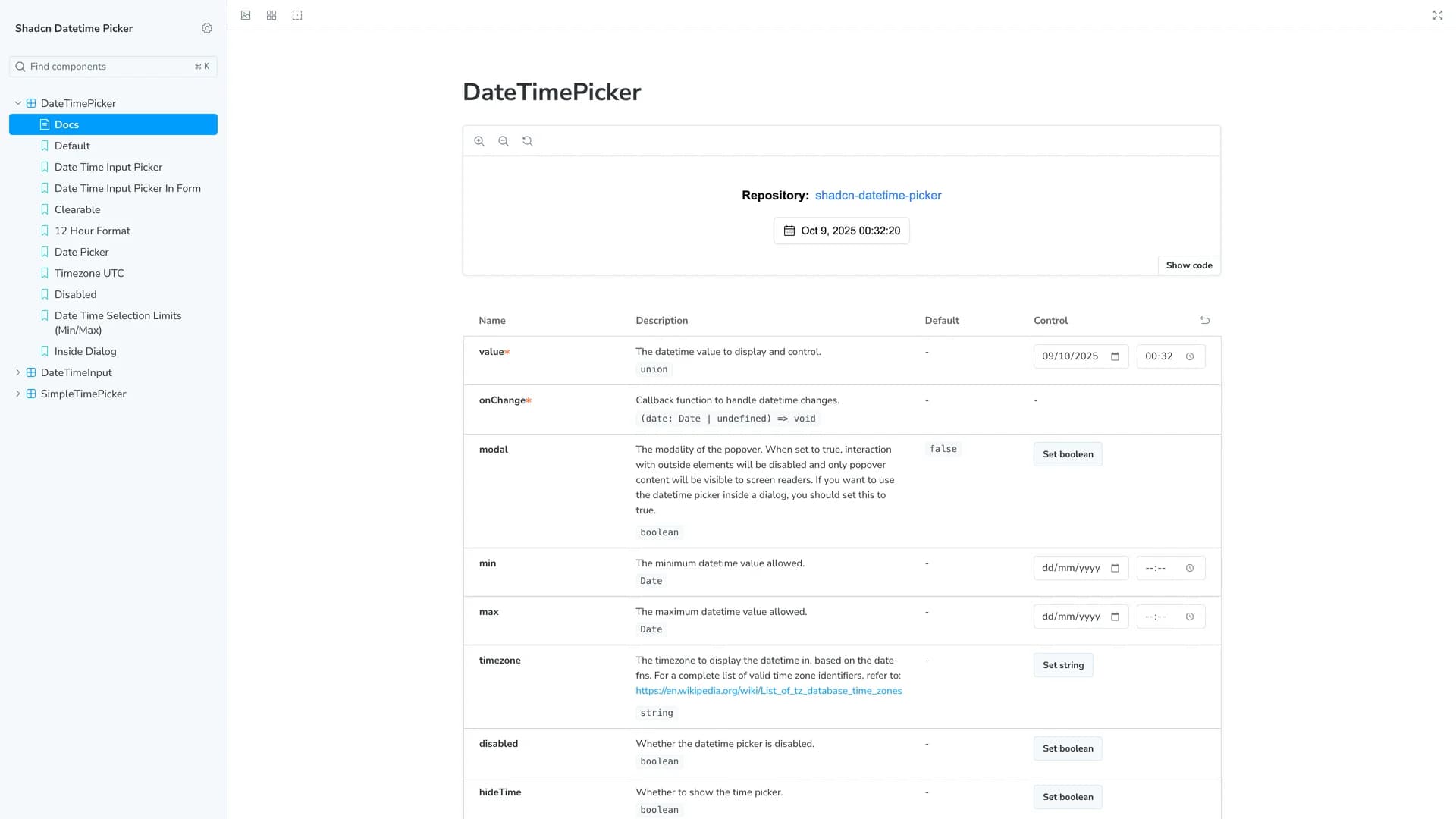
Shadcn Datetime Picker
The shadcn Datetime Picker is a fully-featured, production-ready date and time selection component built with shadcn/ui design principles, addressing the common challenge of handling datetime input with timezone awareness in React applications. Built with Next.js, React, TypeScript, Tailwind CSS, and date-fns for date manipulation, this component extends shadcn/ui's design system with comprehensive datetime functionality including timezone support, date range constraints, and time selection. The component features timezone selection and conversion for global applications, minimum and maximum date constraints to restrict valid date ranges, combined date and time picking in a unified interface, keyboard navigation and accessibility support, customizable date formats and display preferences, integration with popular form libraries like React Hook Form, and responsive design that works seamlessly on mobile and desktop. Unlike basic date pickers, this component handles the complexity of timezone-aware datetime selection, which is critical for scheduling applications, booking systems, and any global application where users across different timezones need to coordinate times accurately. Use cases include appointment scheduling systems for healthcare, consulting, or services, event registration platforms with timezone-aware start times, booking interfaces for hotels, flights, or rentals with date constraints, content management systems with publish/expire datetime fields, and any form requiring accurate datetime input with timezone context. The component eliminates common datetime pitfalls like timezone conversion errors, invalid date selections, and inconsistent time handling across different user locales, providing a robust solution that developers can drop into their shadcn/ui projects.

Shadcn Timeline
The shadcn Timeline is a fully accessible, customizable, and reusable React timeline component built on top of shadcn/ui, perfect for displaying chronological events, project milestones, order tracking, or any sequential information in an elegant vertical format. Built with React, Next.js, TypeScript, Tailwind CSS, and Framer Motion for smooth animations, this component follows shadcn/ui's copy-and-paste philosophy, allowing developers to integrate it directly into their projects with full customization control rather than installing it as a locked dependency. The component features comprehensive ARIA attributes for screen reader accessibility, responsive design that adapts seamlessly to mobile and desktop viewports, multiple size and color variants for different use cases, smooth entrance and transition animations powered by Framer Motion, loading and error states for async data scenarios, TypeScript definitions for type safety, and SSR compatibility for Next.js applications. The timeline supports custom icons and status indicators for different event types, configurable date formatting to match your locale preferences, and flexible configuration through props and Tailwind classes. Use cases include displaying company history and milestone timelines on about pages, tracking order or delivery status in e-commerce applications, showing project progress and phase completion in dashboards, visualizing user activity feeds and notification histories, and presenting educational content or tutorial steps in sequential format. The component is documented in Storybook with live examples, making it easy to understand all configuration options and see the component in action before implementing it in your project.

Circle
Circle is a sleek, modern project management interface directly inspired by Linear's renowned design and user experience, built with Next.js, TypeScript, shadcn/ui, and Tailwind CSS to demonstrate how to create production-quality project management tools with contemporary web technologies. With over 2,200 stars on GitHub, this open-source project showcases best practices for building responsive, performant interfaces that handle issue tracking, project organization, and team collaboration. The application features a clean, distraction-free interface optimized for keyboard navigation and rapid task management, comprehensive issue tracking with status labels, priorities, and assignments, project views with Kanban boards and list layouts, team management with member roles and permissions, responsive design that works seamlessly across desktop and mobile devices, real-time updates for collaborative team environments, and keyboard shortcuts for power users who want to move fast. Circle's design philosophy emphasizes speed and clarity, removing unnecessary visual clutter while ensuring all essential information is accessible within one or two clicks. The codebase demonstrates advanced Next.js patterns including server components, optimistic UI updates, proper TypeScript typing throughout the application, and Tailwind CSS organization for maintainable styles. This project is invaluable for developers building internal project management tools for engineering teams, learning how to replicate Linear's elegant UX patterns, creating issue tracking systems for open-source projects, studying modern Next.js architecture with shadcn/ui, and understanding how to build keyboard-first interfaces. Circle serves as both a functional project management tool and an educational resource for developers who admire Linear's approach to software design.
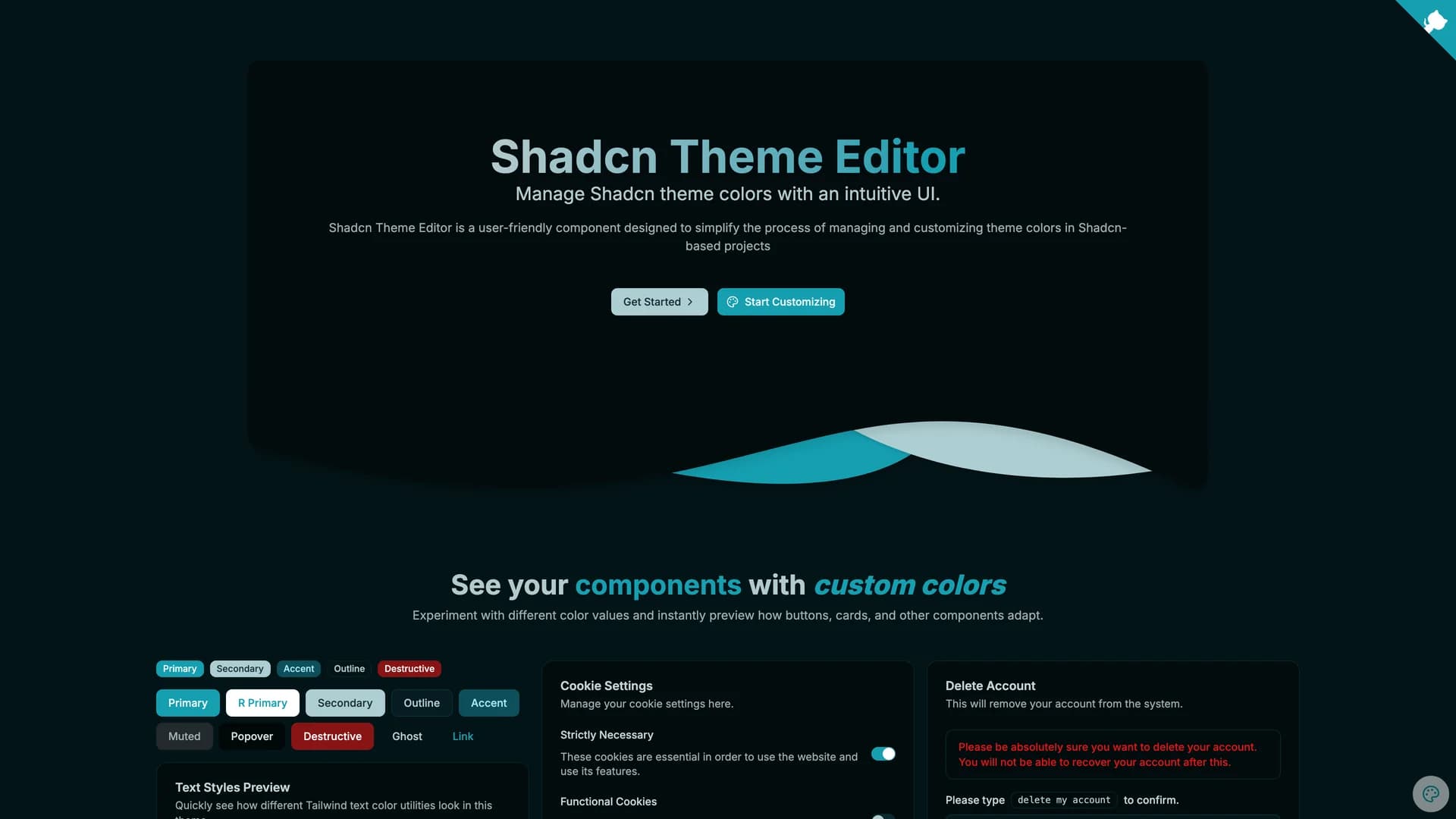
Shadcn Theme Editor
The shadcn Theme Editor is a must-have developer tool that provides an intuitive visual interface for customizing shadcn/ui color themes without manually editing CSS variables or converting between color formats. Built with Next.js, React, TypeScript, and Tailwind CSS, this component allows developers and designers to interactively adjust all theme tokens, preview changes in real-time across light and dark modes, and export ready-to-use CSS configurations. The editor features interactive color pickers for all shadcn/ui theme tokens including background, foreground, primary, secondary, accent, destructive, and border colors, live preview showing how components look with the selected theme applied, automatic HSL to CSS variable conversion eliminating manual color format calculations, one-click copying of generated CSS for immediate integration into projects, preset theme templates to jumpstart customization from popular color schemes, and accessibility contrast checking to ensure color combinations meet WCAG standards. The interface organizes theme tokens by their semantic purpose, making it clear which colors affect buttons versus backgrounds versus text, helping developers understand the shadcn/ui theming system while customizing it. This tool is invaluable for designers creating custom brand themes without CSS expertise, developers building white-label applications requiring multiple tenant-specific themes, teams experimenting with color palettes before committing to final designs, projects needing to match precise brand guidelines with exact color control, and anyone frustrated with manually converting hex colors to the HSL format required by shadcn/ui. The Theme Editor can be installed as a dev dependency via npm or integrated using the Scaflo CLI, bridging the gap between visual design and technical implementation to make theme customization accessible and efficient.